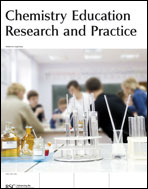Reasonable reasoning: multi-variate problem-solving in organic chemistry
Abstract
In order to understand how students approach multi-variate problems, we report a study on the cues organic chemistry graduate students perceive from mechanism tasks, and the reasoning processes induced by those cues. We used the think-aloud protocol in interviews with sixteen graduate students as they worked on two types of tasks: one, in which they were asked to supply the remaining steps of a partially-completed mechanism, and another, in which they were asked to predict the product of a reaction. Our findings indicate that the students exhibited impoverished interpretations of the representations used in the tasks, and that this lack of representational competence cued students primarily to a case-based reasoning (CBR) approach. CBR allowed the students to reproduce mechanisms without understanding the underlying steps. Furthermore, the participants tended to adapt the task to the retrieved case instead of adapting the retrieved case to the task, thus reducing its efficacy. Rules-based reasoning (RBR), which the students used for about one-third of their attempts, was highly ineffective because it resulted in ‘under-accounting’ of the relevant variables in the tasks. Models-based reasoning (MBR), which was used the least often, was particularly useful for Task 1. However, we believe its reduced efficacy in Task 2 was due to the students’ mental models having inadequate predictive capacity.

 Please wait while we load your content...
Please wait while we load your content...